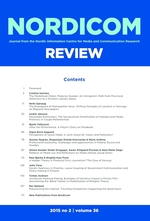期刊簡介
Journal Title:Nordicom Review
As an academic journal covering Nordic media studies, the depth and breadth of the content of Nordicom Review reflects the exploration and understanding of the multi-dimensional media field. The journal not only focuses on the traditional topics of journalism, such as news production, reporting techniques, and journalistic ethics, but also extends to the impact of popular culture on media audiences and how media shape and reflect social values and trends.
In terms of media audiences, it explores how audiences receive, interpret, and interact with media content, and how these interactions in turn influence media production and communication strategies. Research in the field of media history traces the evolution of media, analyzing the roles and functions of media in different historical periods, and how they have evolved in response to social changes. It deals with how political messages are disseminated through the media and the role of the media in the political process, including elections, policy making, and the formation of public opinion. The Public Media section focuses on the social responsibility of public service broadcasting and media, exploring how they promote democracy, provide educational content and reflect social diversity.
中文簡介
《評論》作為一本涵蓋北歐媒體研究的學術期刊,其內容的深度和廣度體現了對媒體領域多維度的探索和理解。該期刊不僅關注新聞學的傳統議題,如新聞制作、報道手法和新聞倫理,還拓展到了流行文化對媒體受眾的影響,以及媒體如何塑造和反映社會價值觀和趨勢。
在媒體受眾方面,探討了受眾如何接收、解讀和互動媒體內容,以及這些互動如何反過來影響媒體的生產和傳播策略。媒體歷史領域的研究則回溯了媒體發展的歷程,分析了不同歷史時期媒體的角色和功能,以及它們如何隨著社會變遷而演變。涉及政治信息如何通過媒體傳播,以及媒體在政治過程中的作用,包括選舉、政策制定和公共輿論的形成。公共媒體部分則聚焦于公共服務廣播和媒體的社會責任,探討它們如何促進民主、提供教育內容和反映社會多樣性。
期刊點評
Nordicom Review由Nordicom出版商出版,收稿方向涵蓋COMMUNICATION全領域,平均審稿速度 52 Weeks ,影響因子指數2,該期刊近期沒有被列入國際期刊預警名單,廣大學者值得一試。
WOS分區(數據版本:2023-2024年最新版)
| 按JIF指標學科分區 | 收錄子集 | 分區 | 排名 | 百分位 |
| 學科:COMMUNICATION | ESCI | Q2 | 64 / 227 |
72% |
| 按JCI指標學科分區 | 收錄子集 | 分區 | 排名 | 百分位 |
| 學科:COMMUNICATION | ESCI | Q2 | 105 / 227 |
53.96% |
名詞解釋:
WOS即Web of Science,是全球獲取學術信息的重要數據庫,Web of Science包括自然科學、社會科學、藝術與人文領域的信息,來自全世界近9,000種最負盛名的高影響力研究期刊及12,000多種學術會議多學科內容。給期刊分區時會按照某一個學科領域劃分,根據這一學科所有按照影響因子數值降序排名,然后平均分成4等份,期刊影響因子值高的就會在高分區中,最后的劃分結果分別是Q1,Q2,Q3,Q4,Q1代表質量最高。
CiteScore分區(數據版本:2024年最新版)
| CiteScore | SJR | SNIP | CiteScore排名 | ||||||||
| 2.8 | 0.684 | 1.203 |
|
名詞解釋:
CiteScore:衡量期刊所發表文獻的平均受引用次數。
SJR:SCImago 期刊等級衡量經過加權后的期刊受引用次數。引用次數的加權值由施引期刊的學科領域和聲望 (SJR) 決定。
SNIP:每篇文章中來源出版物的標準化影響將實際受引用情況對照期刊所屬學科領域中預期的受引用情況進行衡量。
其他數據
| 是否OA開放訪問: | h-index: | 年文章數: |
| 開放 | - | 15 |
| Gold OA文章占比: | 2021-2022最新影響因子(數據來源于搜索引擎): | 開源占比(OA被引用占比): |
| 97.37% | 2 | |
| 研究類文章占比:文章 ÷(文章 + 綜述) | 期刊收錄: | 中科院《國際期刊預警名單(試行)》名單: |
| 93.33% | SCIE | 否 |
歷年IF值(影響因子):
歷年引文指標和發文量:
歷年自引數據:
更多問題
免責聲明
若用戶需要出版服務,請聯系出版商。
